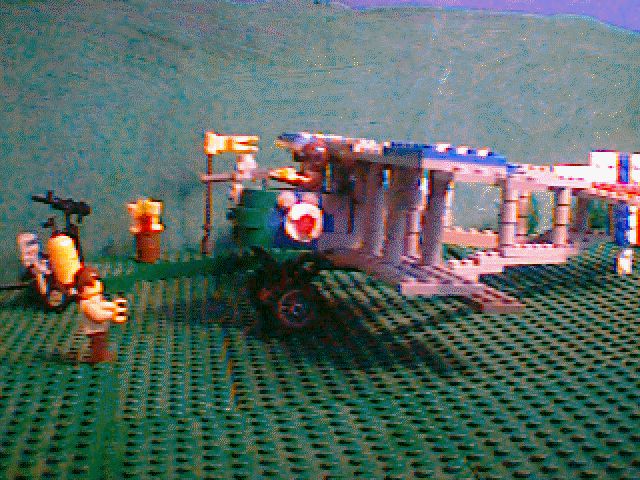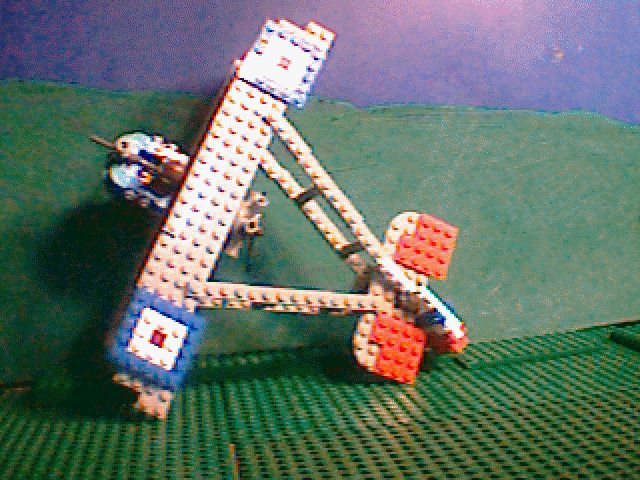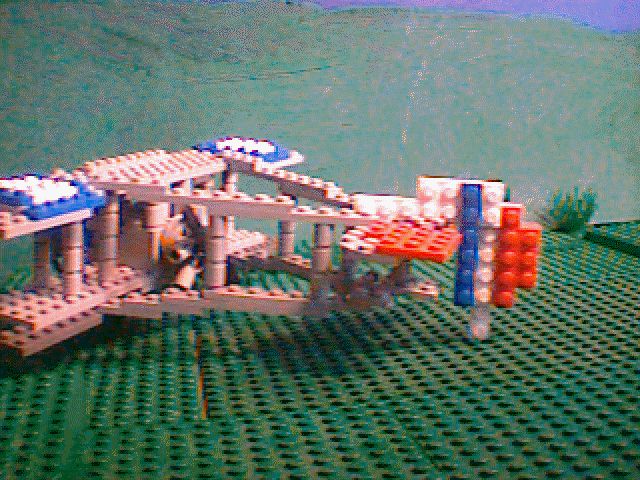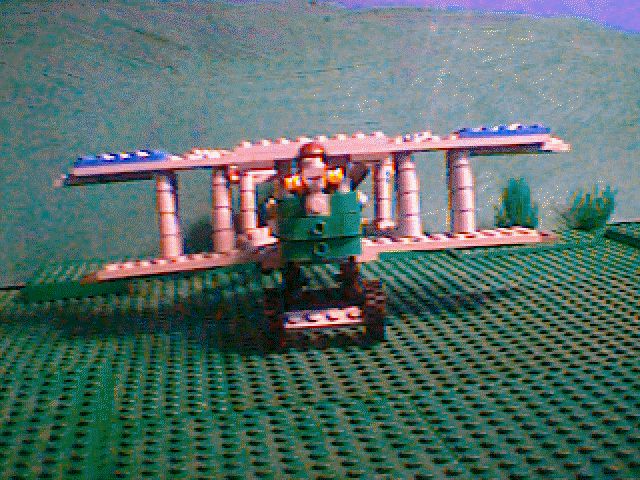The DeHavilland DH2
 The DH2 is an ungainly looking airplane, unlike anything seen today, but keep in mind that it was created but 12 years after the Wright brothers first flew. At the time, it became a lethal fighter in the hands of a skilled and experienced pilot, and was the primary means of stopping the Fokker Scourge.
The DH2 is an ungainly looking airplane, unlike anything seen today, but keep in mind that it was created but 12 years after the Wright brothers first flew. At the time, it became a lethal fighter in the hands of a skilled and experienced pilot, and was the primary means of stopping the Fokker Scourge.
To the left you can see a typical World War I airfield. The mechanic keeps his tools handy to repair the planes on a cart with a petrol tank, while behind the cart you see a mounted machine gun, ready to repel any flying Huns. A bottle of wine awaits the return of the pilot, sadly, too many pilots never returned to drink that wine. A pennant lets the pilot know the wind direction, as taking off or landing into the wind makes it much easier.
You can see a good view of the cockpit above. You can see the front mounted Lewis machine gun, fed from a drum on top of the gun. Spare drums are mounted on the sides of the cockpit.
 The main strange thing about the DH2 is that it is a pusher plane, the engine was behind the pilot, and the airscrew pushed the plane threw the air. This strange arrangement had several advantages. The Allies did not know about interruptor gear that allowed a machine gun to fire through the propellor of a tractor styled airplane without shooting off the propellor, so by moving the propellor to the back, the pilot had an uninterrupted field of fire. The other advantage was pilot comfort, early rotary engines were usually lubricated with castor oil, and they tended to spew a cloud of castor oil behind them. In a tractor plane, the pilot would inhale and swallow of lot of castor oil, which apparently has laxative effects. In a pusher, the castor oil was safely behind the pilot.
The main strange thing about the DH2 is that it is a pusher plane, the engine was behind the pilot, and the airscrew pushed the plane threw the air. This strange arrangement had several advantages. The Allies did not know about interruptor gear that allowed a machine gun to fire through the propellor of a tractor styled airplane without shooting off the propellor, so by moving the propellor to the back, the pilot had an uninterrupted field of fire. The other advantage was pilot comfort, early rotary engines were usually lubricated with castor oil, and they tended to spew a cloud of castor oil behind them. In a tractor plane, the pilot would inhale and swallow of lot of castor oil, which apparently has laxative effects. In a pusher, the castor oil was safely behind the pilot.
 The DH2 uses a rotary engine, as did most other Allied aircraft, and a few German ones. WIth a rotary engine, the crankshaft is fixed, and the cylinders rotate around the crankshaft. The crankshaft is hollow, and gasoline if fed through the crankshaft into the cylinders. The propellor is mounted directly to the cylinders, and spins with the cylinders. It's an odd arrangement, and it made for tricky but nimble handlings. Due to the gyroscopic affects all the rotating cylinders, the DH2 (and other rotary engined planes) would want to always turn to offset the rotation. A skilled pilot would use this to his advantage, turning 270 degrees quicker than other planes could turn 180. A skilled pilot would know how to compensate for this off balance torque when landing and taking off. As for unskilled pilots, well, one of the nicknames of the DH2 was the Spinning Incinerator.
The DH2 uses a rotary engine, as did most other Allied aircraft, and a few German ones. WIth a rotary engine, the crankshaft is fixed, and the cylinders rotate around the crankshaft. The crankshaft is hollow, and gasoline if fed through the crankshaft into the cylinders. The propellor is mounted directly to the cylinders, and spins with the cylinders. It's an odd arrangement, and it made for tricky but nimble handlings. Due to the gyroscopic affects all the rotating cylinders, the DH2 (and other rotary engined planes) would want to always turn to offset the rotation. A skilled pilot would use this to his advantage, turning 270 degrees quicker than other planes could turn 180. A skilled pilot would know how to compensate for this off balance torque when landing and taking off. As for unskilled pilots, well, one of the nicknames of the DH2 was the Spinning Incinerator.
 From the front view, you can see the centrally mounted Lewis machine gun. The first models allowed the pilot to mount the machine gun at various points and swivel it at targets. Eventually, the pilots found it was easier and more accurate to mount the Lewis in a fixed mount, facing foward, and aim the gun by aiming the plane at the target.
From the front view, you can see the centrally mounted Lewis machine gun. The first models allowed the pilot to mount the machine gun at various points and swivel it at targets. Eventually, the pilots found it was easier and more accurate to mount the Lewis in a fixed mount, facing foward, and aim the gun by aiming the plane at the target.
This page was last updated on March 4th, 2001.
Return to my Lego plane page.
Return to my lego links page.
 The main strange thing about the DH2 is that it is a pusher plane, the engine was behind the pilot, and the airscrew pushed the plane threw the air. This strange arrangement had several advantages. The Allies did not know about interruptor gear that allowed a machine gun to fire through the propellor of a tractor styled airplane without shooting off the propellor, so by moving the propellor to the back, the pilot had an uninterrupted field of fire. The other advantage was pilot comfort, early rotary engines were usually lubricated with castor oil, and they tended to spew a cloud of castor oil behind them. In a tractor plane, the pilot would inhale and swallow of lot of castor oil, which apparently has laxative effects. In a pusher, the castor oil was safely behind the pilot.
The main strange thing about the DH2 is that it is a pusher plane, the engine was behind the pilot, and the airscrew pushed the plane threw the air. This strange arrangement had several advantages. The Allies did not know about interruptor gear that allowed a machine gun to fire through the propellor of a tractor styled airplane without shooting off the propellor, so by moving the propellor to the back, the pilot had an uninterrupted field of fire. The other advantage was pilot comfort, early rotary engines were usually lubricated with castor oil, and they tended to spew a cloud of castor oil behind them. In a tractor plane, the pilot would inhale and swallow of lot of castor oil, which apparently has laxative effects. In a pusher, the castor oil was safely behind the pilot. The DH2 is an ungainly looking airplane, unlike anything seen today, but keep in mind that it was created but 12 years after the Wright brothers first flew. At the time, it became a lethal fighter in the hands of a skilled and experienced pilot, and was the primary means of stopping the Fokker Scourge.
The DH2 is an ungainly looking airplane, unlike anything seen today, but keep in mind that it was created but 12 years after the Wright brothers first flew. At the time, it became a lethal fighter in the hands of a skilled and experienced pilot, and was the primary means of stopping the Fokker Scourge.
